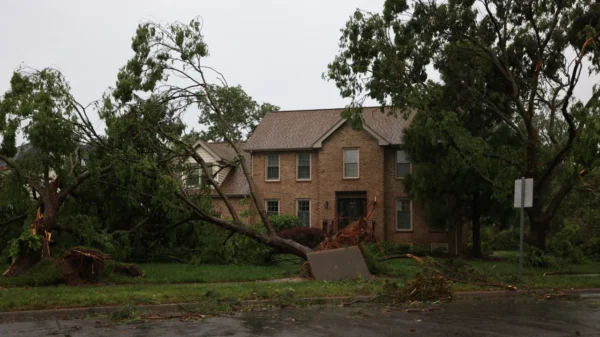Eleven people were reportedly injured and assessment of total number is ongoing, said officials
A magnitude 6.4 earthquake shook parts of northern early Tuesday, jolting people awake, damaging buildings and roads and leaving tens of thousands without power.
to the quake “as a result of medical emergencies occurring during and/or just following” the incident, the Humboldt county sheriff’s office reported Tuesday afternoon.
Centered just south-west of the town of Ferndale in Humboldt county, a small community near the coast about 213 miles (343km) north-west of San Francisco, the quake took place in area where tremors aren’t uncommon. But locals called it the largest in recent memory.
“It was probably the most violent earthquake we have felt in the 15 years I have lived here,” Eureka resident Dan Dixon, 40, said. “It physically moved our bed.” But, he added, his infant had slept through it.
Just after 2.30am local time, phones across the region buzzed to life warning residents of the rattling to come. Moments later, concrete ruptured, water pipes burst and picture frames were thrown from the walls.
The state’s warning system alerted roughly 3 million people across the region, according to california governor’s office of emergency services, giving them at least 10 seconds to take cover.
Wow. This is the aftermath of a strong magnitude 6.4 earthquake that rocked Northern California this morning.
Caroline Titus shared the video of their 140-year-old Victorian home. She writes: “This was our coffee station. Sorry for dark video. Power still out.”pic.
The shaking could be felt across, from south of San Jose, California, into Oregon to the north, according to surveys collected by the United States Geological Survey. There were 80 strong aftershocks that also jolted the region following the quake, some as powerful as 4.6 magnitude, according to Cal OES, and more are expected. There’s a 13% chance of an aftershock larger than 5 magnitude over the next week, but the probability is constantly shifting, said USGS officials Tuesday at a news conference.
Eleven people were reported as injured and Cal OES director Mark Ghilarducci said officials are still assessing the total numbers of injuries.
Risks that remain, as aftershocks could further rattle damaged and vulnerable infrastructure. But nonstructural elements – plates, bookshelves and TVs not anchored – are most dangerous.
“The potential for having a bookshelf come over and injure you is high,” he said, cautioning locals to remove hazards or steer clear of them.
Footage posted on social media showcased the seismic damage, as locals emerged to assess the mess left behind. Household items were strewn across the floor, backyards were filled with debris, and glass from storefront windows shattered across sidewalks. The historic Ferndale bridge, which crosses the Eel River, was cracked and the shaking also felled power lines and spouted gas leaks, causing one building to erupt in flames. The fire was quickly extinguished.
FERNBRIDGE EARTHQUAKE DAMAGE: Damage to Fernbridge following the 6.2 magnitude in Humboldt County. Main road to Ferndale currently closed off by CalTrans as crews inspect for additional damage.
Caroline Titus, a resident of Ferndale, tweeted video in her darkened home of toppled furniture and smashed dishes. “Our home is a 140-year-old Victorian. The north/south shaking is very evident in what fell,” she tweeted. “That was a big one,” she said in another tweet.
After the earthquake, more than 70,000 customers were reported to be without power in the surrounding area, according to power which tracks outages across the country – nearly 75% of people across the area. Two hospitals in the area also lost power and are running on generators.
With a surge in winter weather settling in across the area over the coming days, there are also concerns that displaced people will face increased exposure to the cold. Local and state emergency response teams are working with the National Weather Service and the American Red Cross to prepare, Ghilarducci said, and amplifying efforts to secure access to shelter.
Damage assessments are ongoing and expected to continue for days as engineers and contractors examine impacted foundations, roadways, and homes. But so far, the damage seems to be less than what might be expected from the size of the temblor, according to Brian Ferguson, a spokesperson for the Cal OES.
Scientists have also been deployed into the field to study the damage and features of the quake, said Cynthia Pridmore, a senior engineering geologist for the USGS.
The county of 136,000 residents is in a region of the state that has a long history of large earthquakes, including a magnitude 7.0 in 1980 and a 6.8 in 2014, according to the California Earthquake Authority. Pridmore added that there have been more than 40 large earthquakes in the area over the last century.
“Earthquakes are common in the region around the Mendocino triple junction,” the USGS posted on an informational page about the event, noting a 6.2 magnitude quake that occurred just 20km south-west exactly one year ago. “In the past century, there have been at least 40 other earthquakes of M6 or larger,” they said, “including six earthquakes M7 or larger, within 250 km of the December 20, 2022 earthquake.”
The earthquake also came just days after a small magnitude 3.6 earthquake struck the San Francisco Bay Area, waking up thousands of people at 3.39am Saturday and causing minor damage. That earthquake was centered in El Cerrito, about a 16-mile (25km) drive to downtown San Francisco.
Scientists have, for years, been warning that “the big one” – a catastrophic earthquake rivaling any that’s been experienced so far – is due in California. But they are difficult to predict. Officials have cautioned the importance of being prepared for the event, and smaller ones like this quake.
“We live in earthquake country and this is another example that an earthquake can occur at any time without notice,” Ghilarducci said, noting the importance of having a plan in place. When the power and key infrastructure goes out, having a store of shelf-stable food and plenty of water is essential. He also encouraged more people to download the state’s My Shake App, which worked to give many who were impacted more moments to drop, cover and hold.
“We have seen on numerous occasions that the early warning system is a very valuable tool,” he said. “It is something you can have and be able to have another tool in the toolbox to make your family as safe as possible.”















































